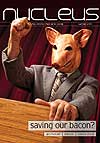The Gospels: one story, many dimensions.
The four gospels form a unique style of literature. Not just biography or history, not just a collection of Jesus' teachings. Instead, they're both narrative (about Jesus) and teaching (sayings of Jesus): Jesus' words are presented as an integral part of the account of his life. This is the way the Holy Spirit inspired the writers to present their accounts of Jesus' earthly ministry. And of course, he inspired four of them. Perhaps this was because different approaches met different needs, but for whatever reason, each is equally valuable and authoritative. The Gospels tell us who Jesus is, what he said and did - and why. And what it means to follow him. They continually re-tell the story of Jesus for every generation after Christ. In the words of Justin Martyr, they are 'memoirs of the apostles', recording the facts about Jesus, recalling the teachings of Jesus, and bearing witness to Jesus.
the context
...of Jesus. As we read the Gospels, we need to consider the context Jesus lived in. At one level, knowledge of first century Judaism helps our understanding of Jesus' interaction with the Pharisees and Sadducees. Reference books can help us here. (1) Appreciation of historical context also can help us understand the forms of teaching that Jesus used: parables, (2) proverbs, (3) poetry, (4) questions (5) and irony. (6)
...of the material. At another level, we need to remember that everything Jesus said, was said in a context: the events around that saying. Not all of his sayings have been passed on to us with those original contexts. Sometimes the writers may not have known the context in which a particular saying happened, and directed by the Spirit they have grouped sayings together in different ways - perhaps thematically rather than chronologically. For instance, the collection of sayings in Matthew 10 are grouped in the topical context of the disciples' missionary task - it seems that Jesus gave these instructions at different times (compare v5 with v18). Luke on the other hand records the same sayings - but scattered throughout his account, perhaps more chronologically, or perhaps because he's chosen to group them in different thematic contexts. (7)
...of the writers. The way the writers select and arrange their material also suggests what prompted them to write their particular account. For example, Mark seems especially interested in explaining Jesus' messiahship in the light of Isaiah's suffering servant. The key point in the Gospel comes in 8:31-33, when the disciples finally realise Jesus is the Christ. Jesus then explains how the Christ must suffer. From then on, as Jesus repeats this, he also teaches that suffering and servanthood is the way his disciples must follow too. Mark probably reflects the 'memoirs' of Peter, who was martyred at a time of general persecution. This historical context can help us appreciate more fully what Mark was trying to do, and how he's done it.
application
...teachings. Once we've done the work of exegesis (understanding the authors' original intent), we can apply Jesus' teachings today in a similar way to the epistles. (8) Remember that obedience to Jesus' commands is not how we become right with God; but the mark of the Christian life because of God's acceptance of us.
...narrative. Stories are not like Aesop's fables, simple morals or precedents. Often they are in the context of teaching, and illustrate the point being made in that particular situation. And they often function as demonstrations of God's Kingdom breaking into this world through Jesus' ministry, showing us who Jesus is and why he's come.
dimensions of interpretation
...horizontally. Thinking 'horizontally' means being aware of the parallel stories in the other Gospels. Not to 'fill in' details from the other accounts - but to identify the differences that help us understand more clearly the distinctive message that this author is trying to get across.
...vertically. Thinking vertically means being aware of the historical contexts, appreciating how a 'story' context that the writer has given to a 'saying' might help us understand the point he is making.
...wholly. The writers were authors, not merely compilers. They wrote under the Spirit's guidance; they weren't free to invent things! But they were able to structure their material creatively to meet their readers' needs. They selected those stories and sayings that suited their purposes best, and arranged and adapted what they selected. We should invest time reading their accounts as they intended. Not just as compilations of quotes, or chronicles of events, but as Gospels. Carefully composed collections of stories and sayings of Jesus that teach us in different ways, who he was, what he said and did and why, and what it means to follow him.
the feeding of the 5,000
Matthew (n=157) |
Mark (n=194) |
Luke (n=153) |
|
John (n=199) |
8.5% |
8.5% |
6.5% |
Luke |
44% |
40% |
|
Mark |
59% |
(n = word count) |
53 words are common to Mark, Matthew and Luke; John has only eight words in common with the other three writers. It seems that the first three Gospels are interdependent in some way, and that John represents an independent telling of the story.
Most scholars think that Mark wrote his Gospel first, and that Luke and Matthew had access to this as well as to other material, some of which they had in common, but that they didn't have access to each other's account. These three Gospels are known as the 'synoptics' (synoptic = common-view); John wrote independently of all three.
































